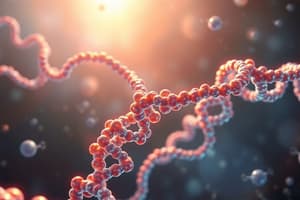Podcast
Questions and Answers
What is DNA ligase?
What is DNA ligase?
- An enzyme essential for DNA replication (correct)
- A unit of hereditary information
- A type of DNA polymerase
- A structure in the DNA molecule
What is the role of DNA polymerase I?
What is the role of DNA polymerase I?
Catalyzes elongation of new DNA and replaces RNA nucleotides.
What does DNA polymerase III do?
What does DNA polymerase III do?
Catalyzes elongation of new DNA by adding nucleotides.
The double helix refers to the structure of DNA.
The double helix refers to the structure of DNA.
What is the function of helicase?
What is the function of helicase?
What is the lagging strand?
What is the lagging strand?
Describe the leading strand.
Describe the leading strand.
What is mismatch repair?
What is mismatch repair?
What is a nuclease?
What is a nuclease?
What does nucleotide excision repair involve?
What does nucleotide excision repair involve?
What are Okazaki fragments?
What are Okazaki fragments?
What is the origin of replication?
What is the origin of replication?
What does primase do?
What does primase do?
What is an RNA primer?
What is an RNA primer?
What is a replication fork?
What is a replication fork?
What is the semiconservative model of DNA replication?
What is the semiconservative model of DNA replication?
What is the function of single strand binding protein (SSBP)?
What is the function of single strand binding protein (SSBP)?
What does telomerase do?
What does telomerase do?
What is a telomere?
What is a telomere?
What is the role of topoisomerase (gyrase)?
What is the role of topoisomerase (gyrase)?
Flashcards are hidden until you start studying
Study Notes
DNA Replication Enzymes
- DNA ligase: Links DNA fragments by covalently bonding the 3' end of a new fragment to the 5' end of a growing DNA chain.
- DNA polymerase I: Adds nucleotides to a growing DNA strand at the replication fork and replaces RNA nucleotides in the RNA primer with DNA.
- DNA polymerase III: Responsible for elongating DNA by adding nucleotides to the 3' end of pre-existing strands or RNA primers.
- Primase: Synthesizes RNA primers by joining RNA nucleotides, providing a starting point for DNA synthesis.
- Nuclease: Enzymes that break down DNA and RNA into individual nucleotides by hydrolysis.
- Telomerase: Lengthens telomeres, containing RNA that serves as a template for new telomere DNA segments.
DNA Structure and Function
- Double helix: The native form of DNA, consisting of two polynucleotide strands coiled in a spiral formation.
- Telomeres: Repetitive DNA sequences at the ends of eukaryotic chromosomes that protect against degradation.
- Single strand binding protein (SSBP): Stabilizes unpaired DNA strands during replication, ensuring they remain open for complementary strand synthesis.
DNA Replication Processes
- Leading strand: Synthesized continuously in the 5' to 3' direction along the template strand.
- Lagging strand: Synthesized discontinuously, creating Okazaki fragments that are later joined by DNA ligase.
- Replication fork: The Y-shaped area on a replicating DNA molecule where new strands are forming.
- Origin of replication: The specific sites where DNA replication begins.
- Okazaki fragments: Short sections of synthesized DNA (100-200 nucleotides) on the lagging strand that must be connected by DNA ligase.
DNA Repair Mechanisms
- Mismatch repair: A process where enzymes fix incorrectly paired nucleotides during DNA replication.
- Nucleotide excision repair: Removes and replaces damaged segments of DNA using the undamaged strand as a template.
Additional Proteins in DNA Replication
- Helicase: Enzyme that unwinds the double helix, creating replication forks.
- Topoisomerase (gyrase): Relieves strain ahead of helicase by managing DNA supercoiling.
Concepts of DNA Replication
- Semiconservative model: Each resulting DNA molecule consists of one parent strand and one newly synthesized strand, preserving half of the original DNA.
Studying That Suits You
Use AI to generate personalized quizzes and flashcards to suit your learning preferences.




